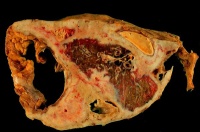Difference between revisions of "Directory:Lawyer Central/Mesothelioma"
m |
|||
| Line 46: | Line 46: | ||
By 1979 the first writs for negligence related to Wittenoom were issued against CSR and its subsidiary ABA, and the Asbestos Diseases Society was formed to represent the Wittenoom victims. | By 1979 the first writs for negligence related to Wittenoom were issued against CSR and its subsidiary ABA, and the Asbestos Diseases Society was formed to represent the Wittenoom victims. | ||
| + | |||
| + | ===Recent Legal Developments=== | ||
| + | Asbestos-related cases increased significantly on the U.S. Supreme Court docket after 1980. The Court has dealt with several asbestos-related cases since 1986. Two large class action settlements, designed to limit liability, came before the Court in 1997 and 1999. Both settlements were ultimately rejected by the Court because they would exclude future claimants, or those who later developed asbestos-related illnesses. ''See'' [http://www.law.cornell.edu/supct/html/96-270.ZO.html ''Amchem Products v. Windsor et al''] and [http://www.law.cornell.edu/supct/html/97-1704.ZS.html ''Ortiz v. Fireboard Corp.'']These rulings addressed the 20-50 year latency period of serious asbestos-related illnesses. | ||
| + | |||
| + | Congress is still considering legislation from 2005 entitled the "Fairness in Asbestos Injury Resolution Act of 2005". The Act would establish a $140 billion trust fund to supplant litigation as a means to compensate victims of asbestos and limit liability. On April 26, 2005, Dr. Philip Landrigan, Professor of Occupational and Environmental Medicine and Chairman of the Department of Community and Preventive Medicine at Mount SInai School of Medicine, [http://www.ewg.org/reports_content/lungcancer/pdf/asbestos_testimony.pdf testified] before the US Senate Committee on the Judiciary against this proposed legislation. He testified that many of the bill's provisions are unsupported by medicine and would unfairly exclude a large number of people who have become ill or died from asbestos: "The approach to the diagnosis of disease caused by asbestos that is set forth in this bill is not consistent with the diagnostic criteria established by the American Thoracic Society. If the bill is to deliver on its promise of fairness, these criteria will need to be revised." Also opposing the bill are the American Public Health Association and the Asbestos Workers Union.[http://jurist.law.pitt.edu/paperchase/2005/05/senate-judiciary-committee-wants.php] | ||
| + | |||
| + | On June 14, 2006, the Senate Judiciary Committee Committee approved an amendment to the Act which would allow victims of mesothelioma $1.1M within 30 days of their claim's approval.[http://jurist.law.pitt.edu/paperchase/2005/05/senate-judiciary-committee-wants.php] This version would also expand eligible claimants to people exposed to asbestos from the September 11, 2001 attacks on the World Trade Center, and to construction debris in Hurricanes Katrina and Rita.[http://www.dailytimes.com.pk/default.asp?page=2006%5C06%5C12%5Cstory_12-6-2006_pg6_25] | ||
==References== | ==References== | ||
Revision as of 21:45, 14 March 2007
| Lawyer Central for Mesothelioma | |
|---|---|

| |
| Has Specialty | Lawyer Central Mesothelioma |
<embed> <script src="http://www.google-analytics.com/urchin.js" type="text/javascript"> </script> <script type="text/javascript"> _uacct = "UA-38898916-1"; urchinTracker(); </script> </embed>
Lawyer Central for Mesothelioma is the definitive listing on the internet for all of your Mesothelioma related law needs.
Sponsored Resources
Google has systematically picked the best lawyers on the web.
<adsense> google_ad_client = "pub-3695520715701375"; google_ad_width = 336; google_ad_height = 280; google_ad_format = "336x280_as"; google_ad_type = "text_image"; //2007-03-06: Centiare google_ad_channel = "9200851493+0332613634"; google_color_border = "336699"; google_color_bg = "FFFFFF"; google_color_link = "0000FF"; google_color_text = "000000"; google_color_url = "008000"; </adsense>
What Is Mesothelioma?
Mesothelioma is a form of cancer that is almost always caused by previous exposure to asbestos.[1] In this disease, malignant cells develop in the mesothelium, a protective lining that covers most of the body's internal organs. Its most common site is the pleura (outer lining of the lungs and chest cavity), but it may also occur in the peritoneum (the lining of the abdominal cavity) or the pericardium (a sac that surrounds the heart).
Most people who develop mesothelioma have worked on jobs where they inhaled asbestos particles, or have been exposed to asbestos dust and fibre in other ways, such as by washing the clothes of a family member who worked with asbestos, or by home renovation using asbestos cement products. There is no association between mesothelioma and smoking.[2]
Legal History
The first lawsuit against asbestos manufacturers was brought in 1929. The parties settled that lawsuit, and as part of the agreement, the attorneys agreed not to pursue further cases. It was not until 1960 that an article published by Wagner et al first officially established mesothelioma as a disease arising from exposure to crocidolite asbestos[3]. The article referred to over 30 case studies of people who had suffered from mesothelioma in South Africa. Some exposures were transient and some were mine workers. In 1962 McNulty reported the first diagnosed case of malignant mesothelioma in an Australian asbestos worker[4]. The worker had worked in the mill at the asbestos mine in Wittenoom from 1948 to 1950.
In the town of Wittenoom, asbestos-containing mine waste was used to cover schoolyards and playgrounds. In 1965 an article in the British Journal of Industrial Medicine established that people who lived in the neighbourhoods of asbestos factories and mines, but did not work in them, had contracted mesothelioma.
Despite proof that the dust associated with asbestos mining and milling causes asbestos related disease, mining began at Wittenoom in 1943 and continued until 1966. In 1974 the first public warnings of the dangers of blue asbestos were published in a cover story called "Is this Killer in Your Home?" in Australia's Bulletin magazine. In 1978 the Western Australian Government decided to phase out the town of Wittenoom, following the publication of a Health Dept. booklet, "The Health Hazard at Wittenoom", containing the results of air sampling and an appraisal of worldwide medical information.
By 1979 the first writs for negligence related to Wittenoom were issued against CSR and its subsidiary ABA, and the Asbestos Diseases Society was formed to represent the Wittenoom victims.
Recent Legal Developments
Asbestos-related cases increased significantly on the U.S. Supreme Court docket after 1980. The Court has dealt with several asbestos-related cases since 1986. Two large class action settlements, designed to limit liability, came before the Court in 1997 and 1999. Both settlements were ultimately rejected by the Court because they would exclude future claimants, or those who later developed asbestos-related illnesses. See Amchem Products v. Windsor et al and Ortiz v. Fireboard Corp.These rulings addressed the 20-50 year latency period of serious asbestos-related illnesses.
Congress is still considering legislation from 2005 entitled the "Fairness in Asbestos Injury Resolution Act of 2005". The Act would establish a $140 billion trust fund to supplant litigation as a means to compensate victims of asbestos and limit liability. On April 26, 2005, Dr. Philip Landrigan, Professor of Occupational and Environmental Medicine and Chairman of the Department of Community and Preventive Medicine at Mount SInai School of Medicine, testified before the US Senate Committee on the Judiciary against this proposed legislation. He testified that many of the bill's provisions are unsupported by medicine and would unfairly exclude a large number of people who have become ill or died from asbestos: "The approach to the diagnosis of disease caused by asbestos that is set forth in this bill is not consistent with the diagnostic criteria established by the American Thoracic Society. If the bill is to deliver on its promise of fairness, these criteria will need to be revised." Also opposing the bill are the American Public Health Association and the Asbestos Workers Union.[1]
On June 14, 2006, the Senate Judiciary Committee Committee approved an amendment to the Act which would allow victims of mesothelioma $1.1M within 30 days of their claim's approval.[2] This version would also expand eligible claimants to people exposed to asbestos from the September 11, 2001 attacks on the World Trade Center, and to construction debris in Hurricanes Katrina and Rita.[3]
References
- ^ United States Department of Health and Human Services.
- ^ "Cigarette smoking, asbestos exposure, and malignant mesothelioma" by Muscat JE, Wynder EL in Cancer Research (1991) volume 51 pages 2263-7 Template:Entrez Pubmed.
- ^ "Diffuse pleural mesothelioma and asbestos exposure in the North Western Cape Province" by J. C. Wagner, C. A. Sleggs and P. Marchand in Br J Ind Med. (1960) volume 17, pages 260-271 Template:Entrez Pubmed.
- ^ "Malignant pleural mesothelioma in an asbestos worker" by J. C. McNulty in Med J Aust (1962) volume 49, pages 953-954 Template:Entrez Pubmed.
